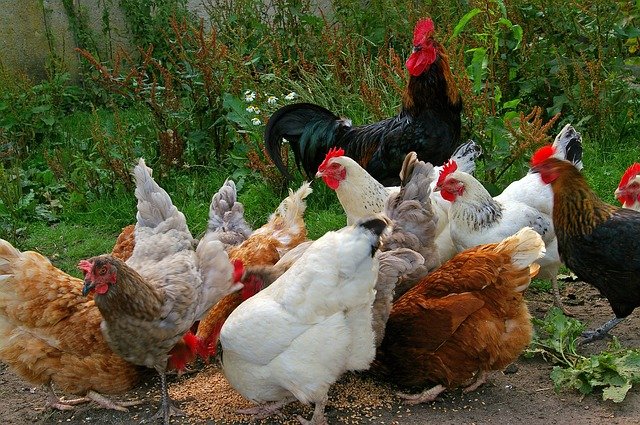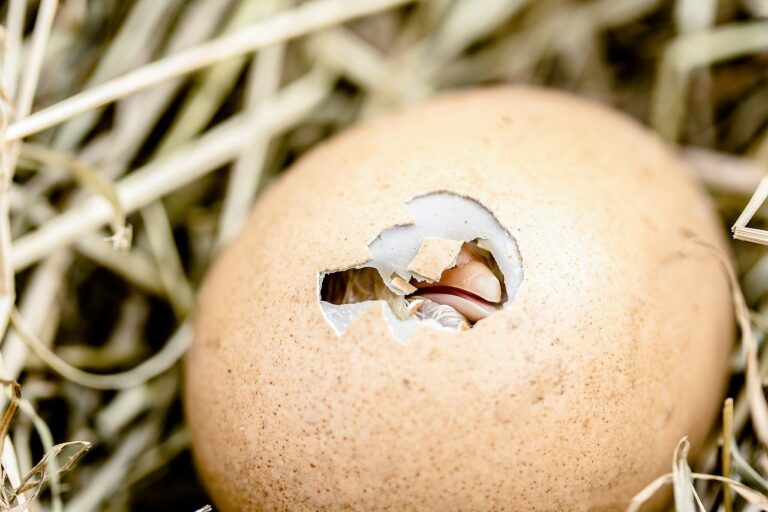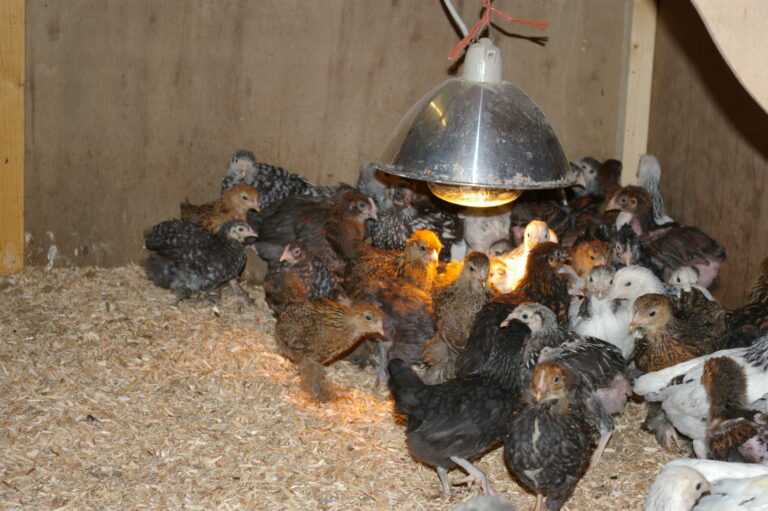General Advice on Chicken Health and Care of Chickens
Food
Chickens are pretty omnivorous. I’ve even heard of one that specialised in catching mice. But it is very important for the chickens health to have a balanced diet. Unless you are very expert, the best way to achieve this is to base your chickens’ diet on one of the propriety pelleted feeds. This can be fed in conjunction with suitable grain such as corn or wheat. The consensus of opinion being to feed pellets in the morning via a protected feeder (to keep the food dry). Then the grain in the afternoon as a scatter food.
Feed at a rate which allows a little left over at the end of the day. This will assure you that every bird is getting enough. Fresh greens are very popular with the birds and certainly of benefit. Yolks won’t be yellow without them, unless you add a dye to the food, like many commercial egg producers. If you can’t get your birds onto grass regularly give them some cabbage or similar.
Once you’re sure the birds are properly nourished a few treats will do no harm and be much appreciated. Kitchen scraps such as bread and cereal for example, or sunflower seeds.
Drink
It is important for the health of your chickens to provide fresh, clean water which must be available during daylight hours. This is best achieved by one of the propriety drinking fountains. These keep a reserve of clean water which fills up a small trough, preventing the water to be fouled. If you lock your birds in at night, it is not necessary to make water available.
Grit
Hens need (flint) grit to grind food in their crop. Some will be included in a good quality food, but its a good idea to supply some ad-lib. Also in the food will be a source of calcium, necessary for eggshells. But many poultry keepers like to supply ground oyster shell, usually mixed in with the grit.
Cleaning
The chicken house will need to be cleaned regularly. Exactly how often depending on the density of birds and the time of year, but ideally once a week. The floor of the chicken house should be covered with sawdust, though this is a misnomer.
It is very important that it should be dust-free wood shavings as chickens have delicate respiratory systems. For the same reason clean, wheat straw, not hay, should be used in nesting boxes, on a layer of sawdust. The floor can be lined with old newspaper first, then sawdust, droppings and all can simply be rolled up. Even easier if your poultry house has sliding floors.
Manure
Poultry droppings make one of the best garden manures. Though used fresh and direct, in quantity, can be too strong for plants. So best allow them to rot down with the old straw and sawdust – it really shouldn’t smell. It is very important to keep all the crevices clean and watch for signs of infestation by red mite or fleas.
Eggs
Hens don’t need a cockerel with them to lay eggs, only for fertile eggs. If these are collected regularly are perfectly OK to eat. The rate of lay will depend on nutrition, contentment, age of the bird, day length and breed.
14 hours of daylight is the optimum day length, and commercial producers may use lights to extend their day. Dusk should be gradual on welfare grounds, to allow chickens time to roost.
Laying
Chickens traditionally start laying again after the winter hiatus on St Valentines day, but you will probably get the odd egg all year round. The proverbial china egg can help stimulate laying. It is very important for chickens to have the correct environment for laying eggs. It needs to be dark and reasonably out of view, like a nesting boxes that are available in many forms.
Traditional utility breeds are usually good layers, and you could expect perhaps 250+ eggs a year from Light Sussex. Some of the old breeds, those bred for meat and the ‘fancy’ show birds are not good layers. Some, like the Brahma, being known as rich men’s birds because they eat so much and produce so little. Brahmas have other qualities though, looks aplenty and they are one of my favourites!).
Collect your eggs at least once a day. You don’t want birds to start sitting on a clutch (unless you want to start breeding! Another reason is if they break an egg and eat it they may get a taste for eggs. Once they start it takes a while to stop them with pot or mustard eggs, trimming beaks etc
Whether to clean eggs is a matter for debate, if you do, wipe them with a clean damp cloth. Remember, eggs are porous and will absorb smells.
Mark the date on the shell with a pencil so you use the oldest first or stack in order. Then you can enjoy the incomparable taste of a really fresh egg.
The Moult
Once a year chickens lose their feathers (not all of them) and grow new ones. They go rather out of sorts and off the lay. But a few weeks will see them in a smart new outfit. It is advisable that birds are in tip top condition prior to the moult. The process takes a lot out of them, so ensure your worming/parasite control is up to date. No other action is required from the poultry keeper while they are moulting. If you do want to add some extra vitamins or ‘poultry spice’ as an encouragement they would be very appreciative.
Flock relations
Chickens have a hierarchical social system, with the stronger, more assertive birds having first crack at feeding. They generally boss the lower orders around and is know as the ‘pecking order’.
You will notice as you watch chickens the order of precedence. This behaviour becomes particularly obvious when new birds are introduced to an established flock. Until the order is re-established the new birds will be bullied, sometimes quite remorselessly. It is often necessary for their protection to segregate new birds whilst they get accustomed to each other. You can use an enclosure within the main run where they can see each other. Gradually they are accepted into the flock. Another method is to introduce the new chickens at night time when the others are asleep. Simply place the new ones onto the perch in the dark coop. When morning comes they do not have the same reaction as if you popped the new ones in daylight.
General well-being
Contented, busy chickens are much more likely to thrive and lay well. Chickens feed mainly by scratching the ground, then pecking (though it’s pretty amusing to watch them chase flies). So having an earth floor or a few inches of bark chippings or similar, will keep them occupied and happy. Another measure is to provide greens in a string bag or on a hook. They will then have to reach up to get at it keeping them active and entertained.
If possible, let them free range. With care, especially during summer through winter, a small number of chickens will not do much damage in a garden. On the contrary, they will eat up a lot of pests – they love slugs. So spread some very fine manure and they’ll be a pleasure to have around.
Keep an eye on your flock’s behaviour, droppings, food consumption. Also any bird that ‘goes quiet’, has a messy tail or loses feathers unusually should be investigated.
Take the time to watch your birds, just for the fun of it.




